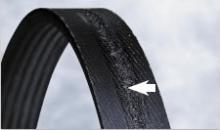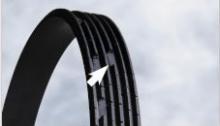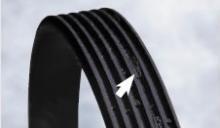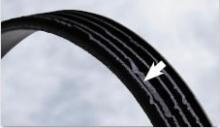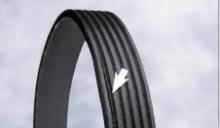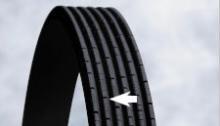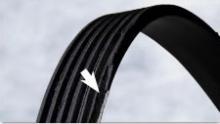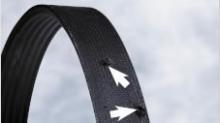With the help of the items below, you'll be able to identify and solve any Belt problems.
Belt abrasion
Both sides of the Belt appear shiny or glazed. In advanced stages, the textile becomes visible.
During operation, the Belt may come into contact with an object such as a flange or bolt.
Replace Belt and remove foreign body. Check belt tension and make sure it is normal.
Loose pieces of material
Pieces or pieces of rubber detaching from a worn Belt. When this happens, the Belt is liable to break at any time.
When cracks run parallel to the tensile cords, pieces of material may detach. Heat and the age of the Belt are the main causes.
Change the Belt for a Gates Micro-V® Belt. Gates belts are designed for high flexibility and heat resistance.
Scrubbing the Belt
Rubber residues from striations accumulate in the belt grooves.
There are several possible causes, including loss of tension, misalignment, damaged or worn Pulleys. This type of problem occurs frequently with diesel engines, but not exclusively.
When the Belt becomes noisy or vibrates, it must be replaced.
Irregular striations on the Belt
The Belt has surface damage, probably due to damaged strands or the tensile cord. Frictional noise can be heard when the Belt is in motion.
A foreign object in the pulley can cause damage and cut the belt.
Change Belt and check Pulley. Replace pulley if necessary.
Poor installation
A groove in the Belt runs out of true.
Incorrect installation of the Belt is a common cause of breakage. One of the belt's outer strands comes out of the Pulley's grooves.
Change the Belt. Ensure that all the strands of the new belt fit correctly into the grooves on the Pulley. Restart the machine for a few cycles and check that the installation is working correctly.
Cracks
Small cracks visible along the ridges
The Belt is exposed to high temperatures, the bending tension around the Pulley causes cracks.
Change the belt for a Gates Micro-V® belt, which is designed to withstand high temperatures and is resistant to cracking. Check pulleys for wear. Change if necessary.
Misalignment of grooves
Belt flanks may appear shiny or side tensile cords may fray. A peculiar noise may occur. In severe cases, the belt may come off the Pulley.
Misalignment forces the Belt to twist as it travels, causing damage.
Replace the Belt and realign the Pulleys. Also check transmission system for damage.
Impacts on the Belt surface
Small holes are visible on the back of the Belt. Notches or dents may be visible, and the textile around them may be damaged.
Elements such as sand or gravel are trapped between the belt grooves and the pulley grooves.
The Belt must be replaced to prevent the tension rope from coming loose and possibly running out.

